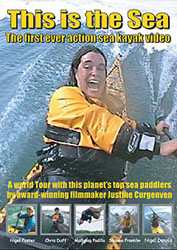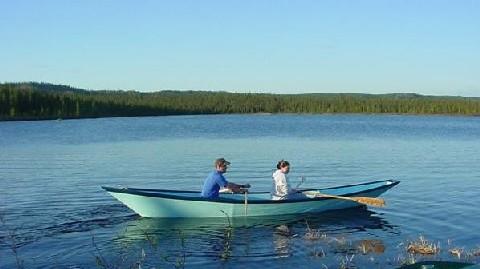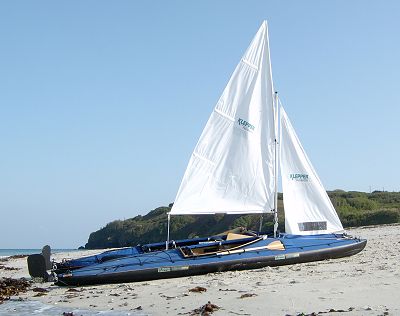More Photos Below!Gallery
[BUMP FROM 7/13/08. Seems like only yesterday!]
If you’re gonna sea kayak you should learn to roll. If like I do you spend a summer playing around getting hot, say by biking, then come near the hot ending of summer I start to thirst for swimming and getting wet and some paddlework. Our autumns are gorgeous for paddling. No better way to cool off and just plain have a blast than to learn something new and get wet along the way. The lakes are as warm as they’re gonna get!
So here’s my new attempt at describing the quickest way to learn to roll a sea kayak. I tried below earlier. Let’s see how it goes this time.
*Wear snug PFD, put on a dry-top if you’re lucky to have one, put on nose-plug
*Stretch with twists and rotations.
*Use a snug-fitting oval-shaped kayak that likes to roll.
*Learn how to paddle: rotate torso, hands low for touring, elbows up for power, press with your feet on properly adjusted pegs.
*Do a bunch of low brace, especially at speed. Go fast, glide, and lean over and feel the support.
*Do a bunch of high braces.
*Rock the kayak aggressively. Get loose in the hips.
Practice bracing while letting your head stay hanging low to the brace side as you come out of the brace. Make a floppy “C” shape with your torso (head flopping) as you rock the hull from side to side and feel how it helps you get the boat back upright. Work on a strong hip-snap, bringing your torso back over the hull after the snap and your head over it last.
*Paddle with your arms in the “paddler’s box”: don’t let your elbows rise above your shoulder, keep ’em snug in.
*Paddle fast then drop into a low brace and dunk your deck, getting it wet, then, using the stability of the brace, right the hull with hip-snap and head-flop.
*Practice sloshing over in a high brace (power face of paddle down) getting the cockpit wet and righting again.
*Hold onto a dock or the bow of a friend’s kayak and let yourself lay into the water then right yourself. Practice this while trying to NOT push/pull down hard on the friend’s boat. Do this while laying relaxed sideways in the water a dozen times.
*Let yourself go all the way upside down, pull yourself up to being awash then right yourself.
*Get out of the water and onto some nice grass. Get in your boat and flip halfway over. Practice righting yourself on the grass. Use your paddle. 6 times.
*Back in water. Get into rolling position. Wind up, kiss the deck, power face to the sky. Big tip: hold paddle shaft so your outward blade is as far forward as possible. (Maybe even hold the end of the inboard blade with your inboard hand. A *long* outrigger helps!) Roll over, hold the crunch position, use your legs/knees. Lightly pat your paddle on the surface of the water. Powerfully unwind while high-bracing and pulling on the paddle and hip-snapping and leaving your head in the water until the very end of your roll. Hey, maybe you did it!
*You’ll need a lot more practice. So have a friend stand alongside you 3 feet of water and they can make sure your paddle is oriented right. As you sweep out they can push your bow away and hold your paddle blade and you can pull on the shaft while they support you as the paddle sweeps out to a right angle from the hull and you can get a feel for what you need to do.
*It’s possible to learn to do your first basic roll in maybe an hour if you’re already a good paddler and are familiar with kayaking. Add an hour or two more practice if you’re fit, flexible and new.
*Now play play play. Test all kinds of ways and conditions you might end up needing to roll. Read up. You’ve had the thrill of doing your first roll. You’ll want to learn another half dozen moves, wet rescues, paddle float rescues, water emptying, wet re-entry, before you’d consider yourself ready for adventuring on the open sea.
***NOTE: Here’s a serious caveat. I assume there are people who believe that only certified instructors should dare to present public info on how to do something like rolling. So I should say that I am NOT certified! …In anything! I can only relate what seems to me to work. Officials will note that if you try this stuff incorrectly and on your own that you can DIE. Indeed, people are OFTEN dying in paddlesport because they don’t give it the proper respect. So heads-up! The approved steps have been studied and compared. My method contains some of them but I have NOT been drilled in all this. I suppose there’s a continuum of skills that need official instructors. Piloting and scuba are perhaps way up there. Rock climbing next. Then kayak rolling. Then skiing. That kind of thing.
[Now here’s the portion from 7/13/08]
Here are my simple tips.
(I checked my last report on this subject and it was VERY longwinded…so this will be a shorty.)
It took me a few years to figure it out. I had some good help, too. But maybe I can teach you how to do it in a jiffy. 🙂
If you paddle a sea kayak much—or ever dare to make any kind of open water crossing of a mile, say—you should probably know how to roll and definitely know how to re-enter from the water (using a paddle-float if need be) and empty water out of a boat from in the water. Otherwise, that’s why plenty of folks die while sea kayaking. (Mostly after drinking, though.)
Anyway, here goes…
Rolling is mostly bracing. You know bracing: the low brace is when you sweep the paddle back and forth on the backside of the blade. A high brace is when you use the power-side of the blade to lean against. Rolling is just a deep high-brace. Well, the finish of a roll is a high-brace. You can practice and get comfy with most everything about a roll just by way of fooling around with high-bracing.
High-bracing is fun because you can easily get a lot of your arm and your boat wet while popping back up each time. For folks like me who are used to mostly flatwater canoeing, getting wet is a refreshing change of pace. I just love being IN the water when kayaking. You’ll also use high-bracing whenever big waves hit you from the side.
Here’s the quickest how-to on rolling: 1. Get into your kayak on land, in the grass; roll over as far as you can (even let the boat get on top of you); use hips and paddle to “roll” back up a few times—that’s the feel! 2. Get in boat in water then work on high-bracing and tipping/rocking vigorously back and forth as far as you can, using your hips, cocking them as much as you can, head-flopping (let your head droop to your shoulder and curve your torso) to let you roll the boat more and more into the water, til your arm and half the deck is getting wet. 3. Hang onto a dock with one hand and let yourself lay down in the water then hip-flip yourself back upright, taking your head out of the water last. 4. Let yourself turn all the way over while hanging onto a dock, then pull up to the halfway-stage and hip-roll, head-flop back up. 5. Then stretch out and wind up til your forward paddle blade is over the other side of the boat and roll your wrist outward til the power-face is upward, slide the paddle all the way forward til your near hand is up against the near blade, do a sit-up crunch and lean forward, then tip into the water. Relax, be cool, hold your breath (wear a noseplug). Keep the crunch, pat the water surface with the paddle face to make sure it’s oriented nicely, then FOCUS and smartly do a sweeping high brace, flip your hip, sweep your torso to the rear deck, leave your head in the water until last, keep holding your breath, and pop right up!
Here’s the longer version…hopefully it still has better flow to it than other how-to descriptions…and more helpful info, too…
First there’s a safety thing to learn about high-bracing: keep your elbows down and in. If you lean out and brace and let your arms get high, let your elbow rise above shoulder-height—you can easily tear or dislocate your shoulder. I’ve felt the wretched pain of a “bad move” several times. Avoid it! Even a mild botch can hurt for days. Keep your paddle shaft close to your chest. This forces you to use torso dynamics and to involve your body weight in what you’re doing. Once you get the feel of that, it’s nice…you want to keep doing it…it will seem unnatural to let your arms “get away” from you. Keeping arms close is also the wimpy thing to do—it’s far easier—you don’t waste energy. You can screw around a lot longer if you keep your arms close because you don’t use arm-power in your moves.
Stretch out beforehand—back (fore and aft, side to side), trunk (twisting), shoulders, hamstrings and such.
When rolling it’s key to be committed. You’re not just an observer being amazed at a trick you’re doing—you have to MAKE it happen. NOW. The FIRST time. You’re not “kind of” learning how to roll. You can’t “maybe” leave your head in the water until last, or “maybe” hip-snap. Do it! And hold that breath until you’re finished and steady. Doing any breathing once you’re above water takes ALL the “umph” out of your final uprighting action. Furthermore, the move is done with intensity from start to finish. You’re not relaxing when you’re leaving your head down while you snap your hips. The experts are perhaps relaxed but they’re doing each action with the right effort, which to beginners will feel like a continuous request for HARD effort until the deed is done. Remember, too, you REALLY want to do it right the FIRST time.
How to Paddle
By the way, here’s a quick primer on sea kayak paddling—with application to canoe paddling. Paddle with your arms slightly bent. Rotate your torso to get power. Hold your arms out mostly in front of you as you paddle. Stop putting on power when your elbow and arm get to your hip. So, wind up and twist your torso and point your shoulder forward then slice the blade in sideways without a splash. Then hit it on the first part of the stroke. Use a little stomach crunch when you first set the blade in the water. Press with your foot. Pull with your hand—press with your foot—it’s kinda like starting a pull-cord lawnmower. Then lift the blade out to the side when the stroke is done. Don’t lift the blade really high off the water when recovering. When kayaking you can keep your arms down low to the deck as you work—especially if it’s windy or you’re going far. When starting out go easy and light with high cadence for the first half hour til you’re really warmed up. Otherwise you pump up your arms and it gets ugly. Medium-light effort does the trick most of the time—that’s all it takes to get a boat (well paddled) to hull-speed. It’s very hard to go any faster. Like, paddling medium-easy will get you 4 mph. Paddling really hard gets you 4.1. Race-style paddling has a lot more wind-up and when kayaking the paddle shaft is more vertical. You keep your elbow high and by your ear. But that ain’t all-day sea kayaking fun stuff.
Rolling, in Infinite Detail
So, back to the roll…in more detail… It’s a fun topic. Maybe if you’ve dabbled in it already you’ll find this somewhat interesting.
Paddle along and go into a turn by leaning hard on a low-brace—make a big sliding splash. To sit back up flop your head toward the water, toward the paddle shaft and your hip will tend to roll the boat up first.
Now just sit there and roll the boat hull back and forth a dozen times while flopping your head from side to side. Get the feel of using your hips to tilt the hull each way.
Go to a dock or use the bow of another kayaker and hang onto it with one hand. Now tip and rock and roll your boat a lot more, using your hips. Why not now just also let your whole torso down into the water. Twist to the side and look to the sky and just relax in the water. Then use the dock or boat-bow and with a twist of the hip right yourself back up. But to do this leave your head in the water until last! When you’re laying relaxed and twisted to the side in the water you’re ALMOST bouyant enough to not need the dock to keep you up. (In fact, there’s a sculling move where you lay on your side in the water, face up and work the paddle so you keep your face out of the water—people can do it as a resting move.)
Now go out and high-brace some on each side. Slap your paddle power-face into the water. Keep your elbows in and lean over. Pull down with your hand and use your hip to flip back upright, drooping your head to the side. You’re making a C-shape with your torso.
Another note: before getting into the water, don’t forget to stretch!
When you’re doing high-braces if the boat squirts forward or if you ever feel that your brace is going too deep and that you’re losing your leverage for tipping back upright—lay your torso back. It helps like flipping your head to the side, only more so. Lay back as much as you can. It makes uprighting the boat easier.
There are, like, 35 ways to do an eskimo roll—we’re just doing one of them here. But the main concepts and elements of many of them are involved.
Get yourself so that high-bracing with half your deck in the water and most of your arm is no problem. Use a dock and lower yourself into the water, lay on your back, then flip yourself back up.
Now use a kayak bow or dock and let yourself turn completely upside down in the water. Don’t let go of the dock or bow. Hang out and look around! WEAR NOSE PLUGS! (At least I have to.) Then pull yourself to the halfway position again so that your torso is just awash—then go back under. Do this a few times. Then use your hips and leave your head behind and lay it back and easily roll back up out of the water.
There’s a rescue move when paddling with a friend that is good to practice. One person rolls over then raises both their hands along the bottom of their hull. You can easily pound on your own hull this way. You can do this waving and pounding to get your pal’s attention. They then turn and ram their boat into yours in the vicinity of your waving hands. You then grab the bow of their boat and roll up. Fun! : )
It’s good practice to hang out upside down in the water for awhile without fretting. You can do it for a minute perhaps if you’re in fair condition and not too fretful. It takes only a few seconds for a friend to turn a boat and go “clunk” into yours. No rush.
Oh, another aside: if you do want to get out of a boat that’s upside down, grab the pull-strap of your sprayskirt yank it off then uncurl yourself out of the boat. It’s like a somersault. Pop up. Don’t let go of paddle or boat. (Some folks use a paddle leash, others just jam the paddle under the bunjies on the front deck. Practice this.) A fun thing is that you do the same thing in reverse to get back into an upside down boat out in the water.
To do a “wet re-entry,” first make sure you have a friend next to you ready to bump your hull (if you’re a beginner). You then duck under the water and curl up and reinsert yourself into your boat, like a reverse somersault. (I think you can even put your sprayskirt on while upside down.) Then pound your hull. Then your pal bumps you and you grab his bow and pull yourself up. Then pump your cockpit dry, for instance. The next step is to practice paddle-rolling after the wet re-entry. It’s really not too hard!
More rolling… I think it really helped me to make my breakthru by fooling around at about this point on a grassy lawn. I got into my boat and tipped it over on land. I used my paddle to right myself and got a feel for it on land. It was kinda goofy but helpful.
Back on the water… Now try some high braces with the paddle held way out—you can even hold onto the end of one blade. Use the paddle as a huge outrigger. Keep your elbows in and sweep the paddle as you lean way into the water, getting really wet. Then pull down on the shaft as you’re sweeping it rearward—flick your hips and lay back, leaving your head hanging low. Right your boat as your stroke ends.
Now we can roll.
Wind yourself up and put your lead hand to the other side of your hull. Lean forward in a maximum sit-up posture. Kiss the deck if you can. Turn the power face of the forward blade UP. Roll your forward wrist strongly outward. Hold the shaft firmly. Slide your hands so the paddle as is far forward as possible. The hand close to your chest might be snug up against the other paddle blade.
Tip into the water!
…Towards your paddle side.
Keep doing your sit-up with your head toward you deck. Because now that is UP toward the sky. Stay all wound-up. Be patient. Don’t move. Pull down a bit with your hand and PAT the surface of the water with your forward paddle blade a couple times. Your forward-rolled wrist is now putting the power-face of your paddle up in the air and it’s patting the surface of the water. It’s getting ready for traction! You could perhaps right how pull a bit and start sculling that paddle and get yourself up to the awash position with your torso up level with the surface of the water. But let’s just do the whole roll.
Stay doing that sit-up. Pat the surface with the paddle to make sure it’s oriented rightly. Then DO YOUR MOVE! Keep your tension and your focus! Sweep your paddle out and to the rear. While it’s moving pull down on the shaft and roll your hips. Leave your torso in the water. As your sweep passes the perpendicular of the hull swing your torso rearward and out of the water over your rear deck. As your sweep ends lift your head. You should be upright, centered and leaning against the back of your cockpit. It’s all one move. Keep holding your breath!
You rolled!
…Now maybe you’ll keep on going and roll to the other side if you’re not careful, so settle down TAKE YOUR FIRST BREATH and maybe take a stroke on the other side—or slap the water and brace.
Anyway, how’s that sound?
Go have fun!
Practice rolling from both sides and from all states of preparedness. Practice getting it on your second try. Then read up and study up and try a few different kinds of rolls. Learn how to scull and rest with your torso in the water and your face looking to the sky so you can breath. Take some classes!
To really seal the deal: order the “This is the Sea” kayaking DVD that I sell. It’s on sale for $20! It’s the only sea kayak CULTURE video. It’s a rare outdoor sport movie that’s made by a woman. There’s a segment in it with 2 of the top lady kayak ROLLERS in the world. It has a great reggae soundtrack and just shows these ladies doing all this great rolling with some voice-over about why they’re so into it. It’ll give you a great feel and a new way of looking at rolling. What’s all this rolling, and wetness and upside down stuff, anyway? THIS SUPERFUN PART OF THE VIDEO ALSO REALLY HELPED ME MAKE THAT FINAL PUSH TO LEARNING MY ROLL! …Here’s the link for ordering: outyourbackdoor.com/article.php?id=777. Or you can just go to the Products > Boating section.
(Let me know of any big tips that I left out. Of course, you should only try this with the help of friends and ideally with someone who is certified and really knows how to teach rolling. But in warm water about 3-4 feet deep one could get a feel for it with friends standing around in the water alongside you. You could do the bow-help rolling with friends in boats who are advanced in general skill.)
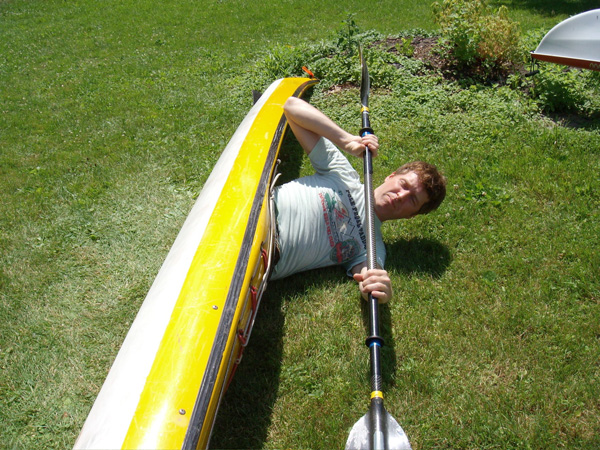
A funny guy in the grass.
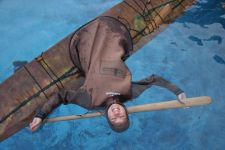
A lady kayaker who really knows what she’s doing. Just hanging out. Mellow. Why not?

